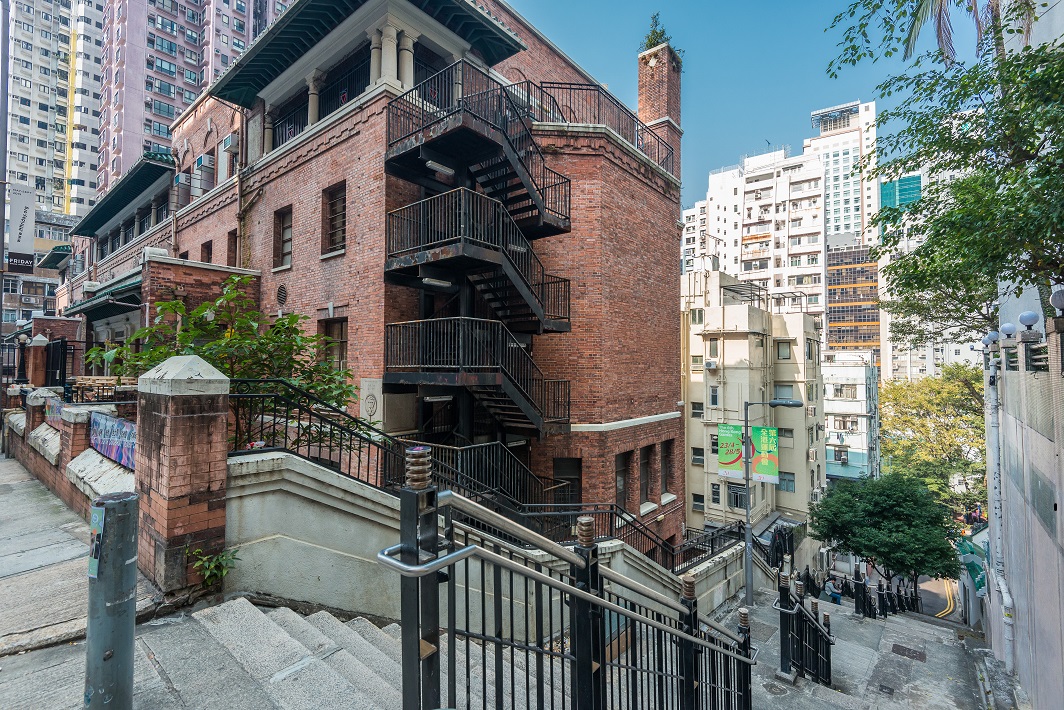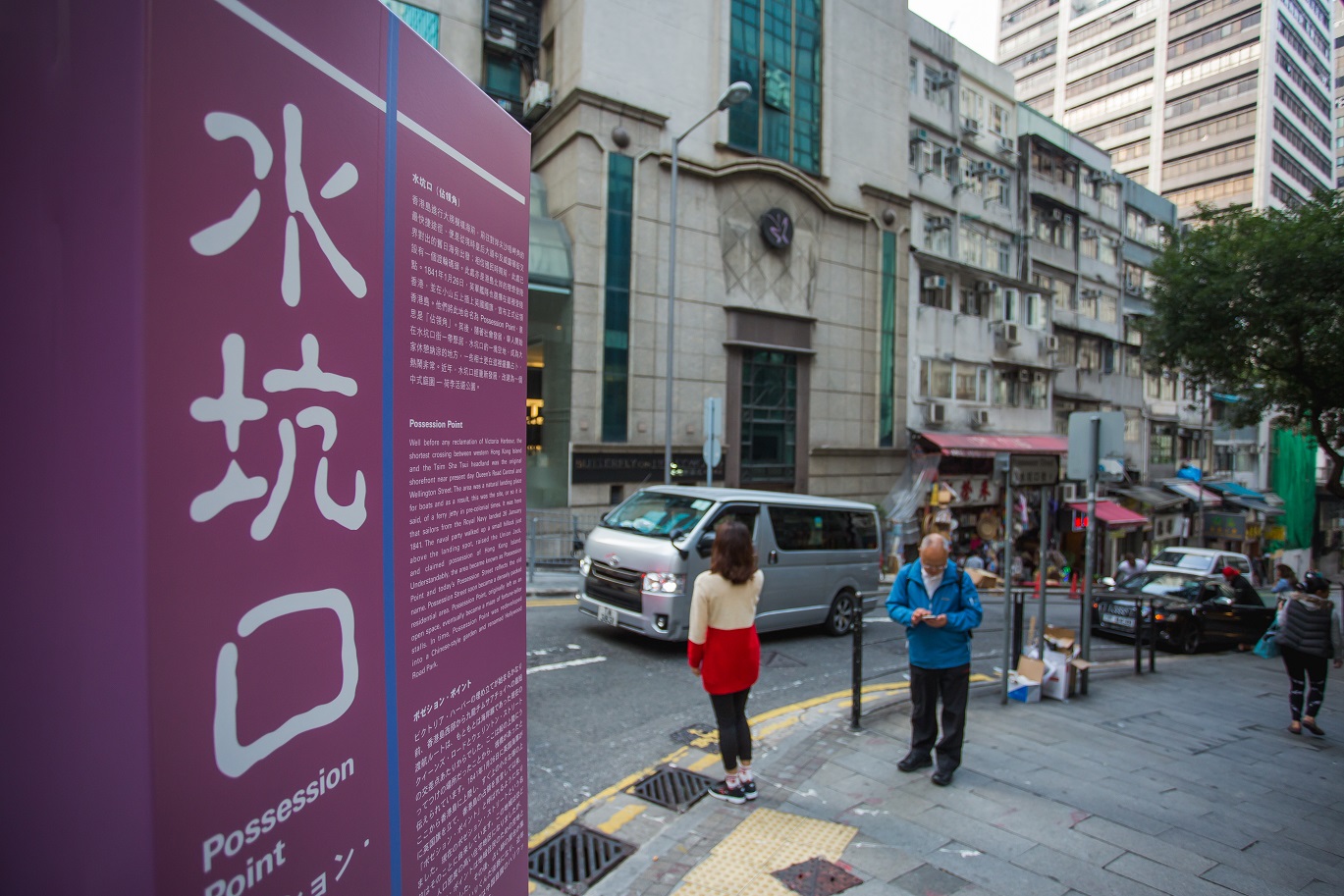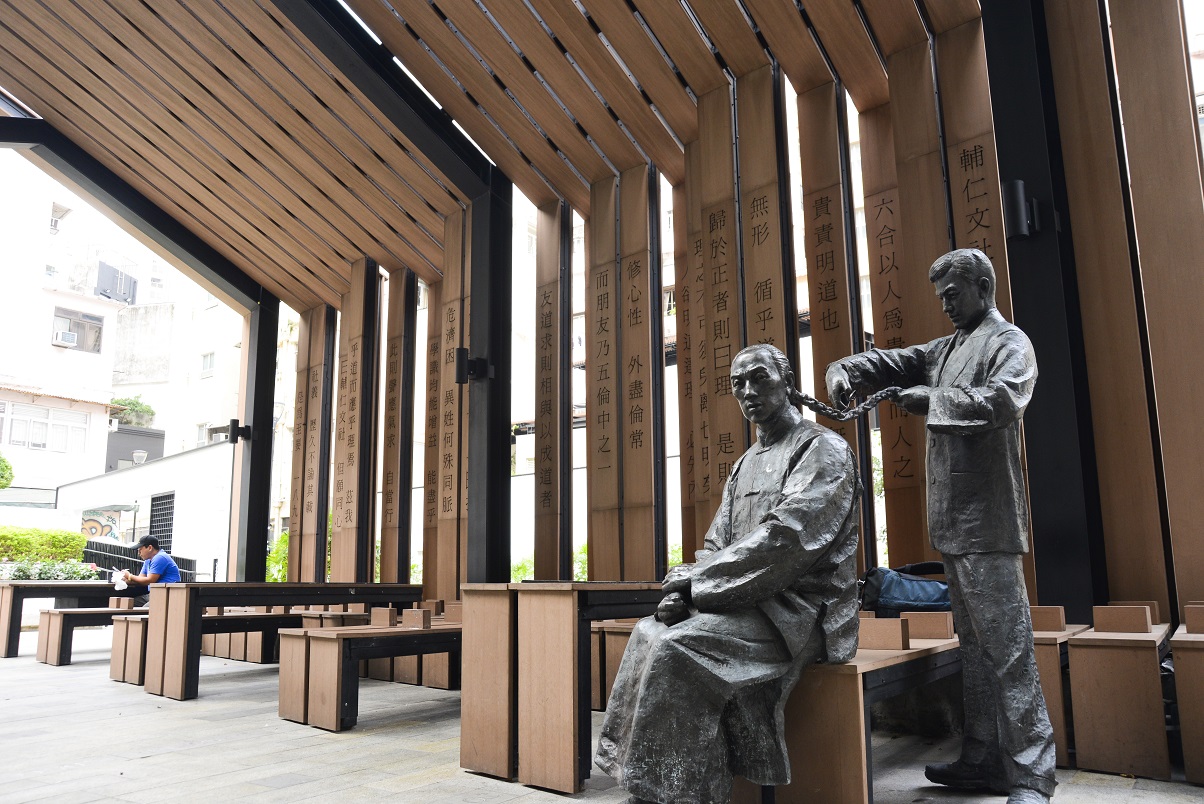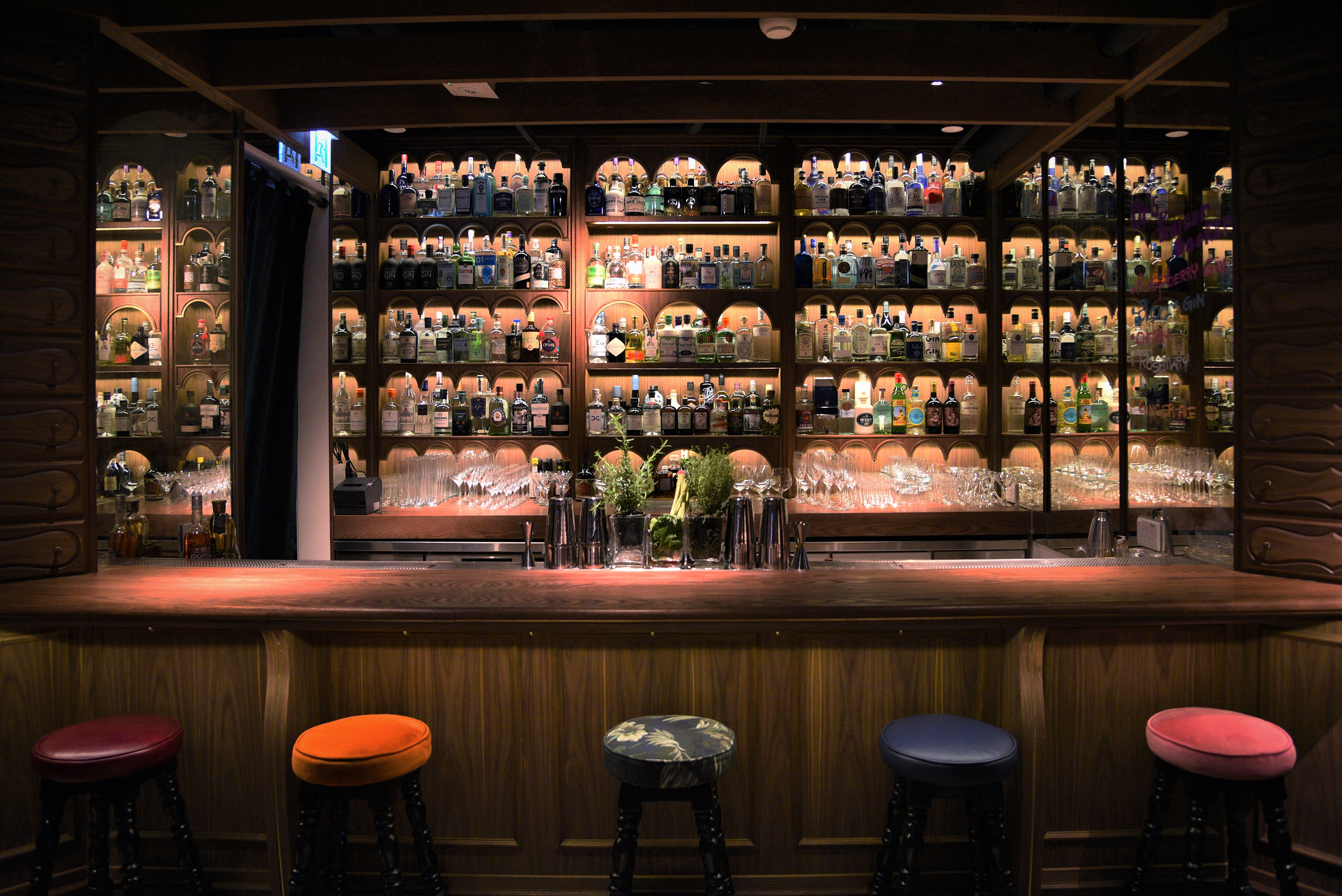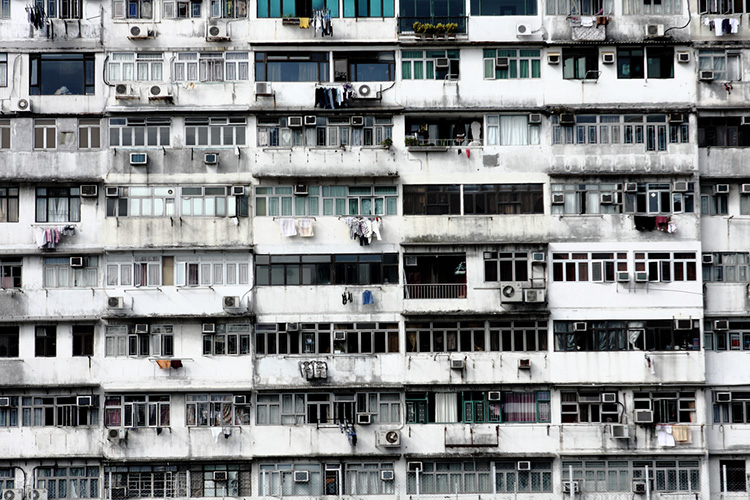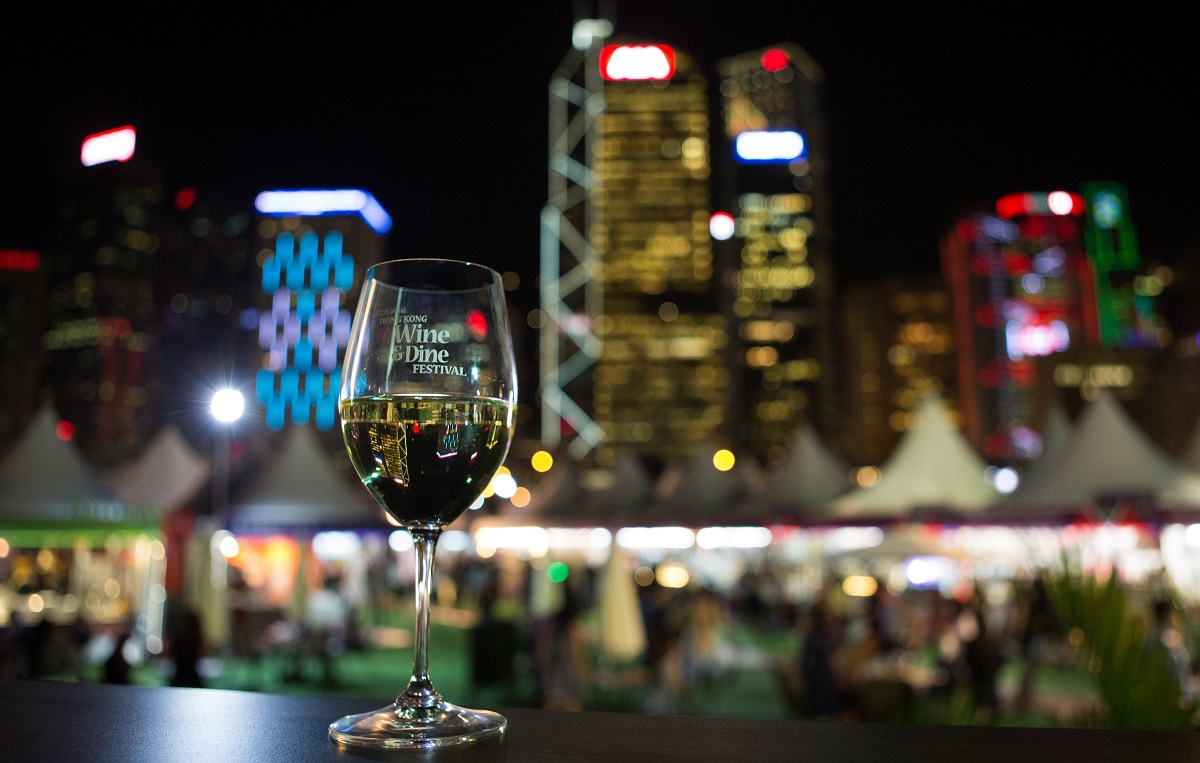The Central and Sheung Wan area was where the story of modern Hong Kong began. From Possession Point, where the British flag was first officially raised, to the Tai Ping Shan area, which was where many Chinese first settled in the 1840s, this journey leads you through some of the oldest streets in HK. The walk takes in Chinese temples, the city’s first bacteriology laboratory, the haunts of a famous revolutionary, Hong Kong’s earliest judicial and police buildings as well as many little shops that still offer glimpses of what life was like when a world city was still in the making.
Possession Street
Ordinary as it may seem, Possession Street has a significant place in the history of Hong Kong. On 25 January 1841, the British navy landed at nearby Possession Point and began 150 years of colonial rule. Originally perched on the waterfront, Possession Street was given a new lease of life through reclamation. The area is now dotted with hip restaurants and boutiques, alongside historic stores where you can still sample a taste of an older Hong Kong.
Address: Possession Street, Sheung Wan, HK
Tai Ping Shan Street
Walk up from Possession Street and you will find yourself on 300-metre-long Tai Ping Shan Street. A number of distinctive ancient temples line the two sides of this small alley: Tai Sui Temple near the staircase, Kwun Yum Temple, and the unassuming Fook Tak Palace.
The most eye-catching of them all is probably the smoky, red temple under an iron sheet, called ‘Kwong Fook I Tsz’. Built in 1856, it is a classic example of a temple that fulfilled diverse roles. It was an ancestral temple for migrant families, and a shelter for the ill. The bodies of immigrant workers who passed away were also kept here until they could be transported back to their hometowns. For those who could not afford to have their remains sent home, memorial tablets would be set up for them here.
To date, the temples dotting Tai Ping Shan Street are still frequented by worshippers. Each temple was built for a different deity and served a different function. Some visit Tai Sui Temple to pray for good fortune, while others pray for wealth at Kwun Yum Temple.
Address: Tai Ping Shan Street
Hong Kong Museum of Medical Sciences
This Edwardian brick building is a symbol of the development of medical sciences in HK. After the bubonic plague hit the city in the late 19th century, the colonial government stepped up efforts in medical development, which eventually led to the establishment of the first bacteriology institute. The laboratory came into service in 1906 as the city’s first clinical laboratory for public health, and the cornerstone of the development of medical sciences in Hong Kong. It is also the world’s first museum comparing Chinese and Western pathologies.
Address: 2 Caine Lane, Mid-Levels, Sheung Wan, HK
Tel: +852 2549 5123
Website: www.hkmms.org.hk
Man Mo Temple
Ladder Street was constructed in the 1840s and connected the Mid-Levels with Sheung Wan, bridging what was then a mostly Western community with a mostly Chinese one. Now, as you descend from Ladder Street, the green-roof of Man Mo Temple will come into sight between the surrounding high rises.
Estimated to have been built between 1847 and 1862, Man Mo Temple is a complex comprising Man Mo Temple, Lit Shing Kung and Kung Sor. Man Mo Temple pays tribute to the God of Literature and the God of War, whilst Lit Shing Kung was created for all heavenly gods. Kung Sor was an assembly hall for resolving community disputes.
This well-preserved historic building houses a bronze bell dating back to 1847 and a sedan chair from 1862, and comprises granite pillars, granite door frames, engraved wood plaques and ancient mural paintings.
Address: 124-126 Hollywood Road, Sheung Wan, HK
Tel: +852 2540 0350
Also read: Bani J rediscovers Hong Kong…and it’s time you do too!
Pak Tsz Lane Park
Central was a perfect breeding ground for revolutionary movements in the late 19thcentury and early 20th century. The free mobility of people, goods and funds in Hong Kong proved favourable to groups such as the Revive China Society and Tongmenhui, which were founded by the great Chinese revolutionary Dr Sun Yat-sen, who spent many years in Central and Sheung Wan.
Sheltered from Hollywood Road, Gage Street and Aberdeen Street, Pak Tsz Lane Park was the site of an important vent in the history of Chinese revolutionary movements. On 13 March 1892, Yeung Ku-wan and Tse Tsan-tai founded the Furen Society, a meeting place for revolutionaries, at 1 Pak Tsz Lane, which is right next to the park. The society eventually merged with Sun’s Revive China Society.
In memory of the event, Pak Tsz Lane Park features exhibition panels and interactive facilities tracing the development of the group’s revolutionary activities. The pathway used by society members back then is preserved as the entrance of the park. The quiet space, which comprises white walls, black frames and fences as well as cut-out details, slowly reveals the development of Furen Society’s history layer after layer.
Address: Pak Tsz Lane, Central, HK
Tai Kwun
The Central Police Station Compound represents the introduction of the British judicial system to Hong Kong. In the early days of the colony, the Chinese community would have gone to temples to settle disputes, as they had done for centuries. Over time, they accepted the authority of the British system and this building continues to stand near Chinese temples as a reminder of the unique East-meets-West heritage of this neighbourhood.
Tai Kwun, meaning ‘big station’ in Cantonese, was a nickname for the police compound. The large complex comprises 16 Declared Monuments including what used to be the Central Police Station, Central Magistracy and Victoria Prison. In the mid-19th century, it housed the offices of the police, the magistracy and the prison, marking its place in history as the heart of the legal system.
Historical significance aside, Tai Kwun is a magnificent work of architecture. The former Police Headquarters building is a resplendent example of Neoclassicism. The barracks, built between 1862 and 1864, is the oldest within the complex and is known for its distinctive Roman-style arch. It is worth noting that these buildings have individual pathways for transporting convicts between the police station, magistracy, and prison.
The revitalisation of Tai Kwun is now under way. With the addition of two new buildings, the complex will function as an integrated space for history, culture and arts.
Address: 10 Hollywood Road, Central, HK
Website: www.taikwun.hk
Pottinger Street
Near Tai Kwun, Pottinger Street and its surrounding area gives a good sense of what the lives of Central’s early dwellers would have been like. The stone slabs spanning the entire Pottinger Street were laid unevenly for a reason: some sections of this street between Hollywood Road and Connaught Road Central were particularly steep, and the pavement of unevenly stone slabs made it easier for commuters and merchant bearers to walk on,and for rainwater to flow down. Because of the unique design, locals still refer to it today as ‘Stone Slab Street’.
There were also stalls on either side of the street when it was built in the 19th century. Originally, they sold household goods, or offered services such as shoe and pot repairing, as well as clothing alteration. Today, as consumer habits have changed, most of them sell festive costumes or handicrafts.
Address: Pottinger Street, Central, HK
Also read: Travelling to Hong Kong? Your ultimate local’s guide to the best food in this city
